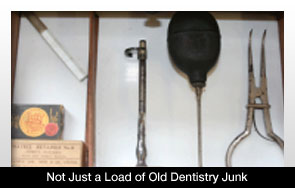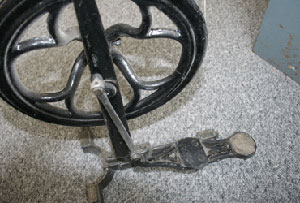 |
Dentaid’s mission is to improve the oral health of disadvantaged communities around the world. It does this primarily by inviting donations of dental equipment from dentists in the United Kingdom and redistributing them in the countries in need.
Since the charity began, Dentaid has helped establish almost 200 charitable dental treatment clinics in more than 50 countries around the world.
For the last five years, one complete dental surgery has left Dentaid’s workshops for overseas every 10 working days. Hundreds of smaller shipments have also been dispatched, including instrument kits to equip health workers to provide dental care in remote rural communities. The flipside of this is that, at times, the dental equipment donations are worth more as collectables or antiques than as equipment that can be recycled and used out in the field.
Here, we take a look at some old dental curiosities lurking in the warehouse of Dentaid and suggest that there may be a novel Christmas present or two among them.
 The pedal-operated dental drill, circa 1910, was used for dental treatment of patients at Ballarat Hospital for the Insane, Victoria, Australia but, more interestingly, was also used by the United States army during the World War II due to the shortage of dental equipment. Its engine has the drill on the end of a 98-cm elbowed arm and is connected to a tall, thin, vertical pole, the lower part of which supports a 30-cm diameter vertical flywheel, which is operated by a foot pedal. The pedal has two round rubber foot grips and is slim with elegant cutout design. The piston connects to the axel of the wheel (which has curved, petal-shaped spokes) and a fly-belt leads from the wheel to two small cogwheels at the top of the pole, and then to two more at the elbow of the arm.
The pedal-operated dental drill, circa 1910, was used for dental treatment of patients at Ballarat Hospital for the Insane, Victoria, Australia but, more interestingly, was also used by the United States army during the World War II due to the shortage of dental equipment. Its engine has the drill on the end of a 98-cm elbowed arm and is connected to a tall, thin, vertical pole, the lower part of which supports a 30-cm diameter vertical flywheel, which is operated by a foot pedal. The pedal has two round rubber foot grips and is slim with elegant cutout design. The piston connects to the axel of the wheel (which has curved, petal-shaped spokes) and a fly-belt leads from the wheel to two small cogwheels at the top of the pole, and then to two more at the elbow of the arm.
Dentaid also has a wooden portable cabinet containing equipment needed for dealing with less significant oral problems. It is difficult to determine the time period during which it was used due to the limitations in the research area. However, it is likely that this was used somewhere in early 20th century.
A spokesperson said: “This guess is based on some of the contents of the box. For example, we were able to find some products made by Parke, Davis & Co, which was a subsidiary of the pharmaceutical company Pfizer, which patented substances such as cocaine and PCP and used them as medicine. One of their products was adrenalin cocaine (containing almost pure adrenaline and cocaine), which could be obtained and used by anyone. However, cocaine was eventually made illegal, meaning that this kind of product could not be used in a portable dental cabinet.
“Some of the items within the box included a dental or tooth key with an ivory handle. The pattern on the handle had been carved manually and was made in England; most likely in the mid-19th century. The dental key is an instrument that was used in dentistry to extract diseased teeth.
Modeled on a door key, the dental key was used by first inserting the instrument horizontally into the mouth. Its claw would then be tightened over a tooth. The instrument was rotated to loosen the tooth. This often resulted in the tooth breaking, causing jaw fractures and soft tissue damage.
Diane Platt, head of fundraising at Dentaid, said: “Dentaid is planning on selling these items and the cash raised will help support many of the projects we have waiting for funding.
“Many of these items would make such an unusual present for anyone with an interest in dentistry or would make a fun talking point if used as a display in your practice waiting room.”
If you are interested in any of the items, then visit dentaid.org.
 |










